Module 1—Motion
Acceleration
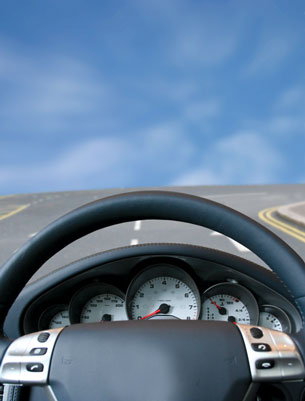
© andres/BigStockPhoto
When you travel in a car, you experience a change in position over a given period of time. And the rate of change in position is defined by the vector quantity velocity. But what happens if the velocity changes too? The rate of change of velocity is defined by the vector quantity acceleration.
Consider this example of acceleration: When the light turns green at an intersection, applying pressure to the gas pedal causes the drive train (engine and transmission) to produce an acceleration that changes the velocity of the car. The concept of acceleration, however, is not always that simple. The direction of the acceleration vector is the direction of the change in velocity, which may not be in the same direction as the velocity itself.
acceleration: a measure of the rate of change of velocity
Acceleration is expressed as an equation, ![]()
Quantity |
Symbol |
SI Unit |
acceleration |
|
m/s2 |
change in velocity |
|
m/s |
time interval |
Δt |
s |
Δ means change.
 Watch and Listen
Watch and Listen
Watch the animation titled Acceleration to see the effect of acceleration on motion.
 Self-Check
Self-Check
SC 11. Explain what happens when the direction of the acceleration is opposite to the direction of the velocity.
SC 12. What happens when the direction of the acceleration is perpendicular to the direction of the velocity?
 Self-Check Answers
Self-Check Answers
SC 11. The speed decreases instead of increasing.
SC 12. The direction of the motion changes, but the speed remains the same.
 Lesson 2 Lab: Acceleration
Lesson 2 Lab: Acceleration
Introduction
The simulation used for this lab contrasts the concepts of velocity and acceleration. As you complete it, you will able to answer the question posed at the beginning of this lesson about how many accelerators there are in a Smart car.
This simulation lets you study and compare the concepts of velocity and acceleration. You can learn more about the simulation by reading the Show Me found at the top of the simulation screen.
Problem
What is the relationship between velocity and acceleration? Can you accelerate without changing speed?
Open the 2D Acceleration simulation; then continue with the procedure.
Procedure
To complete the Observations and Analysis section of the lab, you will need to adjust either the initial velocity or acceleration vectors on the simulation.
This can be done by clicking on the desired vector and dragging it out.
![]() Click and drag the velocity vector to change the initial velocity of the object.
Click and drag the velocity vector to change the initial velocity of the object.
![]() Click and drag the acceleration vector at any time to adjust the acceleration of the object.
Click and drag the acceleration vector at any time to adjust the acceleration of the object.
Observations and Analysis
LAB 12. Set up the simulation for each of the listed conditions in the following table. Then determine whether the initial motion of the moving object is speeding up, slowing down, or changing directions. Choose speed up, slow down, or change direction to describe the initial motion of the moving object.
a.  Acceleration is in the opposite direction of the initial velocity.
Acceleration is in the opposite direction of the initial velocity.
b.  Acceleration is in the same direction as the initial velocity.
Acceleration is in the same direction as the initial velocity.
c.  Acceleration is at right angles to the initial velocity.
Acceleration is at right angles to the initial velocity.
 Module 1: Lesson 2 Assignment
Module 1: Lesson 2 Assignment
Remember to submit the answer to LAB 13 to your teacher as part of your Module 1: Lesson 2 Assignment.
LAB 13. According to the figure below, the velocity and the acceleration have a negative direction. Compare this to your observations from Lab 12.
-
Does a negative acceleration necessarily mean that something is slowing?
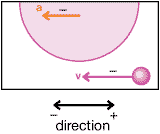
-
What orientation of velocity and acceleration will cause something to initially slow down?
-
What orientation of velocity and acceleration will cause something to initially speed up?
LAB 14. On the simulation, set the initial acceleration and velocity as shown in the following figure. Run the simulation, and observe the motion of the object. Explain what happened to the direction of the initial velocity, and suggest a common type of motion that follows a parabolic path similar to the one you observed.
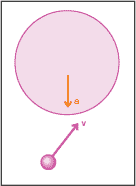
 Module 1: Lesson 2 Assignment
Module 1: Lesson 2 Assignment
Remember to submit the answer to LAB 15 to your teacher as part of your Module 1: Lesson 2 Assignment.
LAB 15. Set up the simulation to illustrate the motion of a baseball that is thrown straight up.
-
Above each of the following words, draw the initial velocity vector and the constant acceleration vector.
velocity acceleration
-
Is there a point on the trajectory where the ball has zero velocity? Where on the trajectory does this occur?
-
Is there a point on the trajectory where the ball has zero acceleration? Explain.
LAB 16. On the simulation, add five obstacles by clicking the Obstacles box (![]() ). By adjusting only the acceleration, try to move the object over each obstacle, starting with obstacle 0 and ending with obstacle 4. Does the acceleration “steer” the object? Explain.
). By adjusting only the acceleration, try to move the object over each obstacle, starting with obstacle 0 and ending with obstacle 4. Does the acceleration “steer” the object? Explain.
 Module 1: Lesson 2 Assignment
Module 1: Lesson 2 Assignment
Remember to submit the answers to LAB 17 and LAB 18 to your teacher as part of your Module 1: Lesson 2 Assignment.
LAB 17. Based on your observations from the simulation, do you think it is possible for an object to accelerate yet neither speed up nor slow down? Explain why or why not.
LAB 18. Based on your observations from all the previous exercises, it is clear that acceleration will change the magnitude and/or direction of the velocity. With this in mind, complete the following list of accelerators common to all vehicles.
-
the _______________________, which causes an acceleration that maintains or changes the car’s velocity, controlled by the gas pedal
-
the _________, which causes an acceleration that opposes the car ’s velocity, controlled by the brake pedal
-
the ___________________, which causes an acceleration that changes only the direction of the car’s velocity
Lab Summary
What is the relationship between velocity and acceleration? Can you accelerate without changing speed?
Acceleration is a measure of the change in velocity during a given time interval. Therefore, acceleration is a measure of the rate of change of velocity. Since a change in direction changes the velocity but not necessarily the speed, you can accelerate without changing speed.
 Self-Check
Self-Check
SC 13. On page 30 of your textbook, complete question 1 of “1.3 Check and Reflect.”
 Self-Check Answer
Self-Check Answer
SC 13.
Given
All directions are forward.
(a) ![]() = 0.00 m/s
= 0.00 m/s ![]() = 2.80 m/s ti = 0.00 s tf = 0.50 s
= 2.80 m/s ti = 0.00 s tf = 0.50 s
(b) ![]() = 2.80 m/s
= 2.80 m/s ![]() = 9.80 m/s ti = 0.50 s tf = 3.00 s
= 9.80 m/s ti = 0.50 s tf = 3.00 s
(c) ![]() = 11.30 m/s
= 11.30 m/s ![]() = 11.60 m/s ti = 5.00 s tf = 6.00 s
= 11.60 m/s ti = 5.00 s tf = 6.00 s
Required
(a) ![]() from 0.00 s to 0.50 s
from 0.00 s to 0.50 s
(b) ![]() from 0.50 s to 3.00 s
from 0.50 s to 3.00 s
(c) ![]() from 5.00 s to 6.00 s
from 5.00 s to 6.00 s
(d) What is happening to ![]() and
and ![]() over 6.00 s?
over 6.00 s?
Analysis and Solution
Choose the forward direction to be positive.
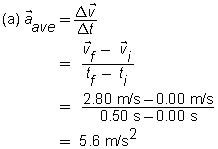
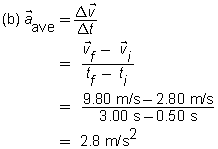
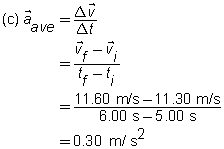
Paraphrase
(a) The acceleration during the first 0.50 s is 5.6 m/s2 [forward].
(b) The acceleration during the 0.50 s to 3.00 s period is 2.8 m/s2 [forward].
(c) The acceleration during the 5.00 s to 6.00 s period is 0.30 m/s2 [forward].
(d) The acceleration decreases, and the velocity increases.
 Module 1: Lesson 2 Assignment
Module 1: Lesson 2 Assignment
Remember to submit the answers to the questions in TR 2, TR 3, TR 4, and TR 5 to your teacher as part of your Module 1: Lesson 2 Assignment.